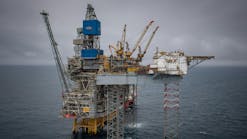Norway has passed legislation that will lead to increased state participation and funding in oil and gas exploration on the Norwegian continental shelf.
Storting (parliament) decided to abolish sliding scale terms in Norwegian exploration licenses, which enabled the state to take 50% interest or more in field development projects when they received Norwegian government approval.
Meantime, Norwegian North Sea oil flow rose to a record average 2.3 million b/d last October, topping the previous record of 2.27 million b/d set in April.
U.K. oil production rebounded to more than 2 million b/d for the first time since January, with total volume for October averaging 2.01 million b/d. Onshore production contributed 80,000 b/d of that volume.
NORWAY'S CHANGE
Storting's removal of the sliding scale means the state must decide its involvement at the outset of an exploration/development project. The government, through operating company Den norske stats oljeselskap AS, will pay a larger share of exploration costs, while operators pay less, said the Ministry of Petroleum and Energy.
Statoil has maintained at least 50% participation in all licenses to date. Removal of the sliding scale will not reduce the overall state interest in field development, but it will increase flexibility.
State participation for the Norwegian sector as a whole will still average at least 50%, said the ministry. However, the state may vary its interest from field to field. Statoil may take only 30% in one development project and 70% in the next, for example.
The new terms will apply to the 14th licensing round and those following. There will be no change to terms in current licenses.
The ministry last June detailed the 50 blocks or part blocks to be offered in the 14th round. There are 25 in the North Sea, 13 on the mid-Norwegian shelf and 12 in the Barents Sea.
OIL PRODUCTION
County NatWest WoodMac, Edinburgh, said Norway's oil production surge was due largely to increased flow from Gyda, Gullfaks, Snorre, Veslefrikk, and Statfjord fields.
Doubled water injection capacity and a new production well boosted Gyda flow by 11,000 b/d from September, raising average production to a field record 80,000 b/d.
Completion of summer maintenance work in Statfjord field meant production could be raised by 101,000 b/d during October to an average 698,000 b/d for the 85.3% Norwegian share of the field.
WoodMac predicted U.K. production will continue to average more than 2 million b/d until the 1993 maintenance season begins. That will be helped by start-up of Gannet field late last October and expected production from Piper and Lyell felds, scheduled about the end of this month.
Danish production averaged 164,000 b/d during October, up from 157,000 b/d in September. Netherlands production fell 1,000 b/d to 31,000 b/d in October because of the steady decline in flow from all four Dutch oil fields.
Norway's gas production fell 1% from September to 2.74 bcfd for October. The other Northwest European sectors saw a seasonal rise in demand.
British gas demand rose sharply in October to 6.3 bcfd, up from 3.75 bcfd in September. U.K. imports of Norwegian gas fell to 430 MMcfd in October from 510 MMcfd in September.
Dutch gas production rose to 1.66 bcfd for October from 1.26 bcfd for September. Danish production rose 129 MMcfd from the September figure to 420 MMcfd for October. Irish production also rose-to 239 MMcfd, a 15 MMcfd gain from September.
Copyright 1992 Oil & Gas Journal. All Rights Reserved.

